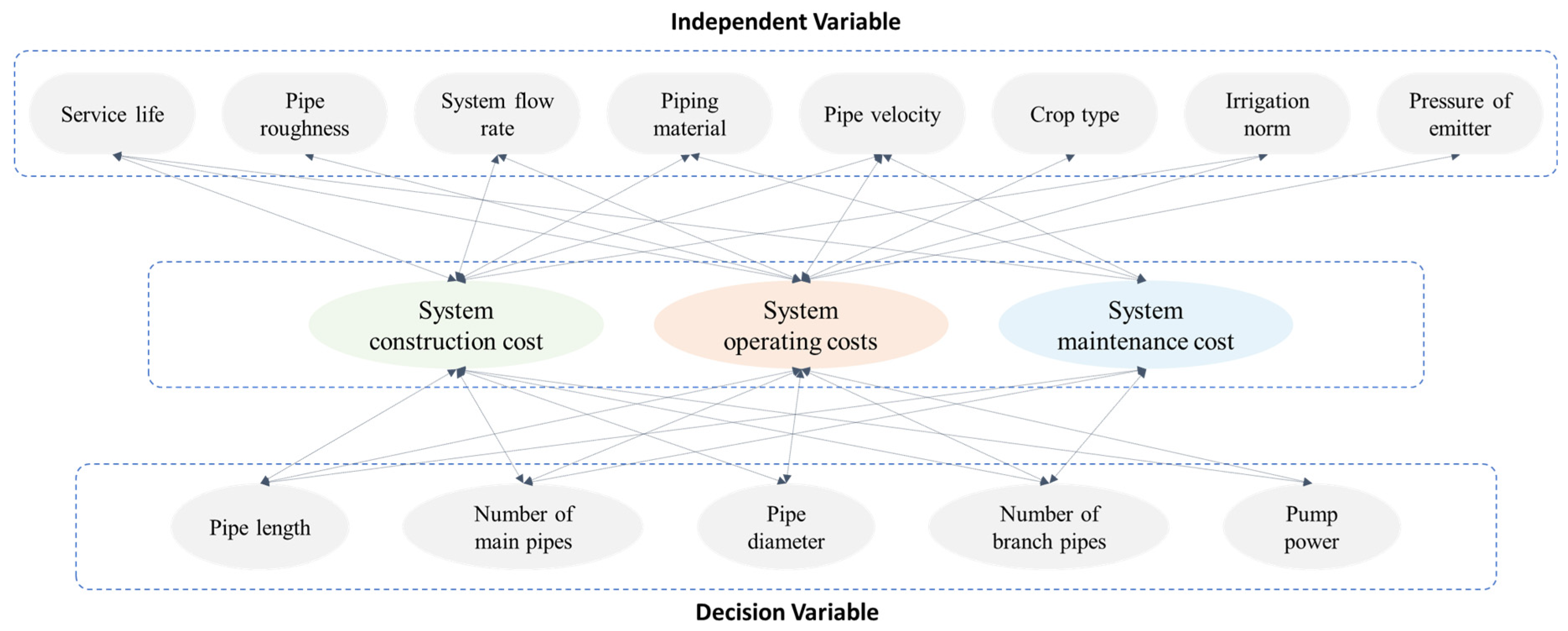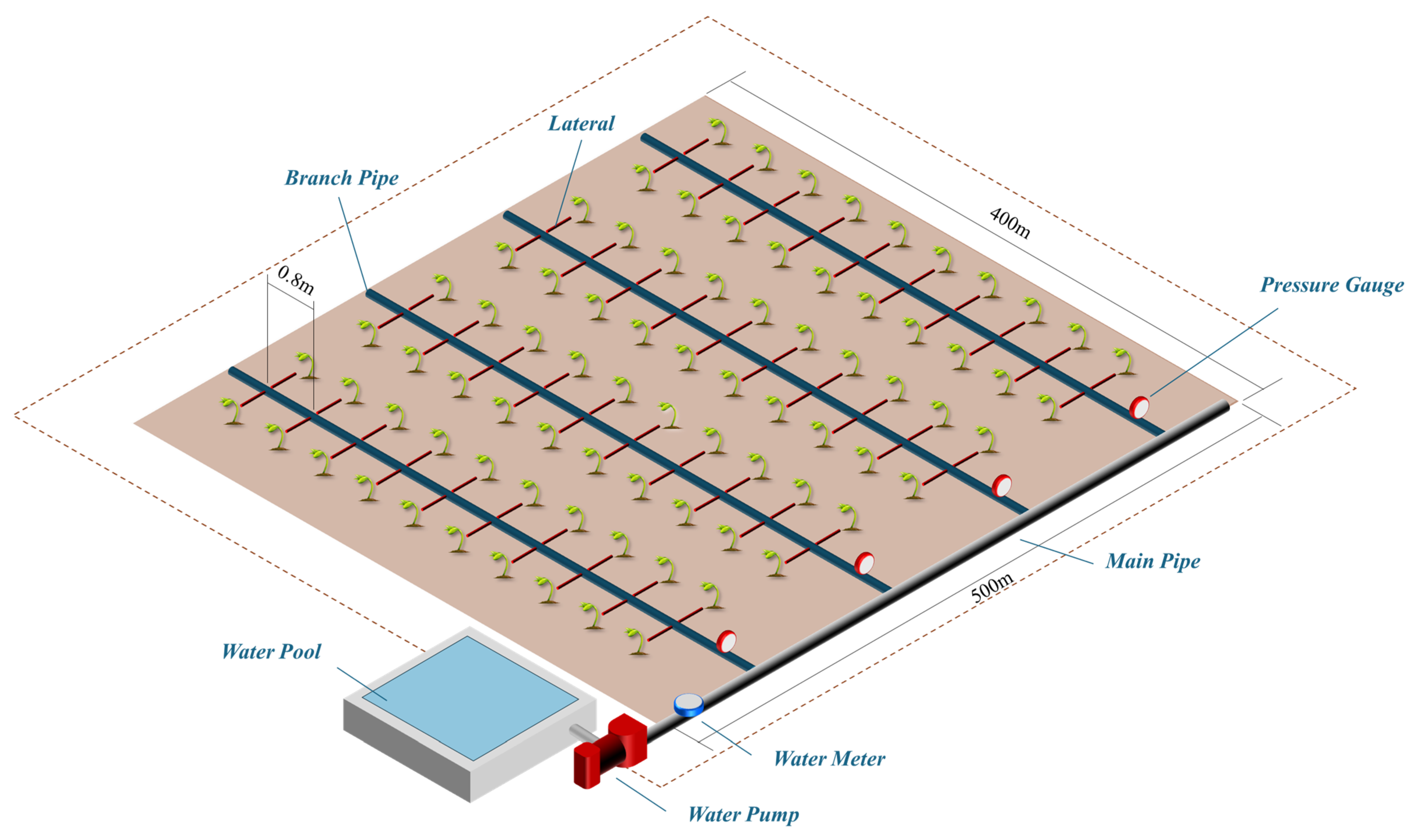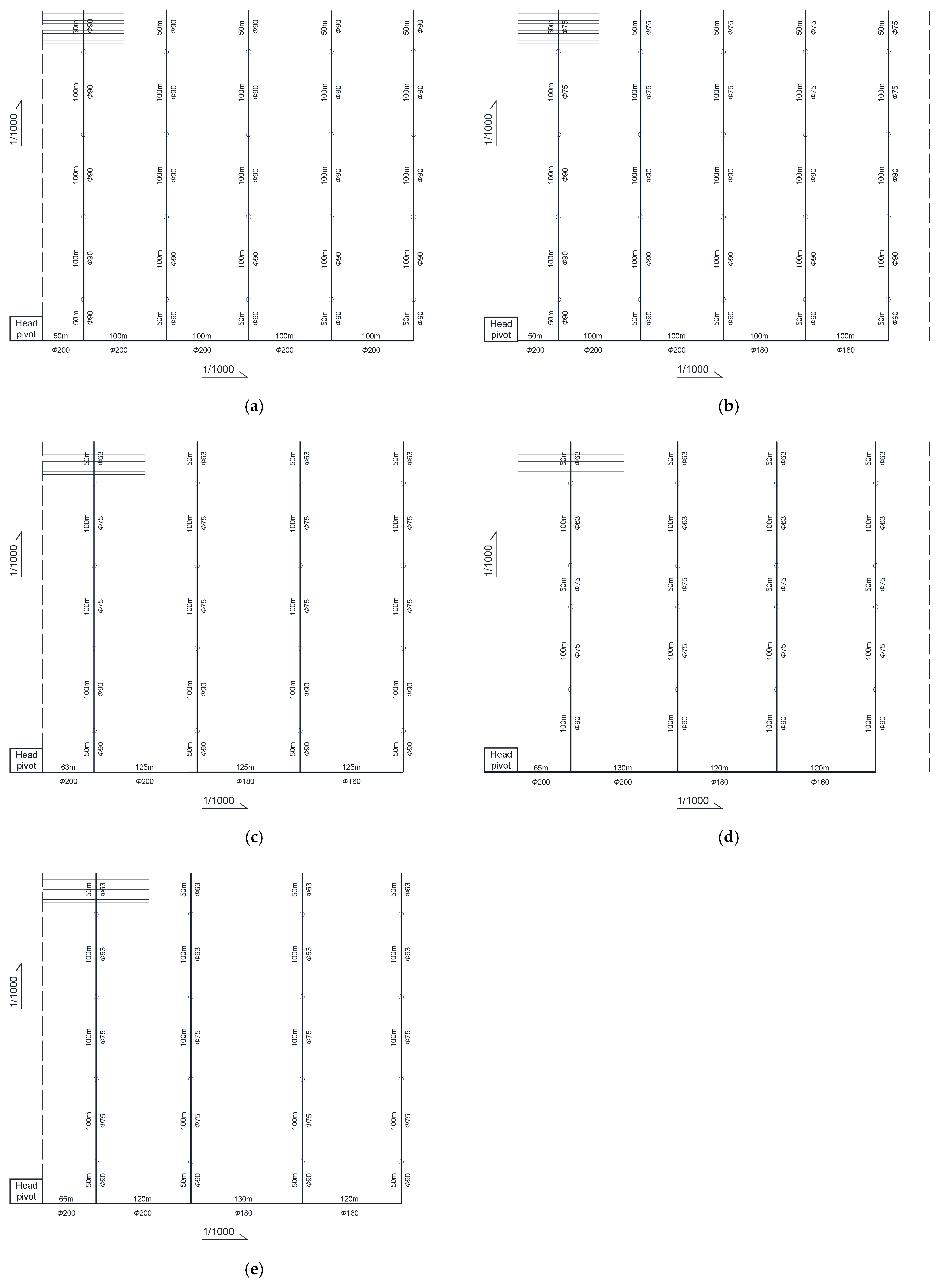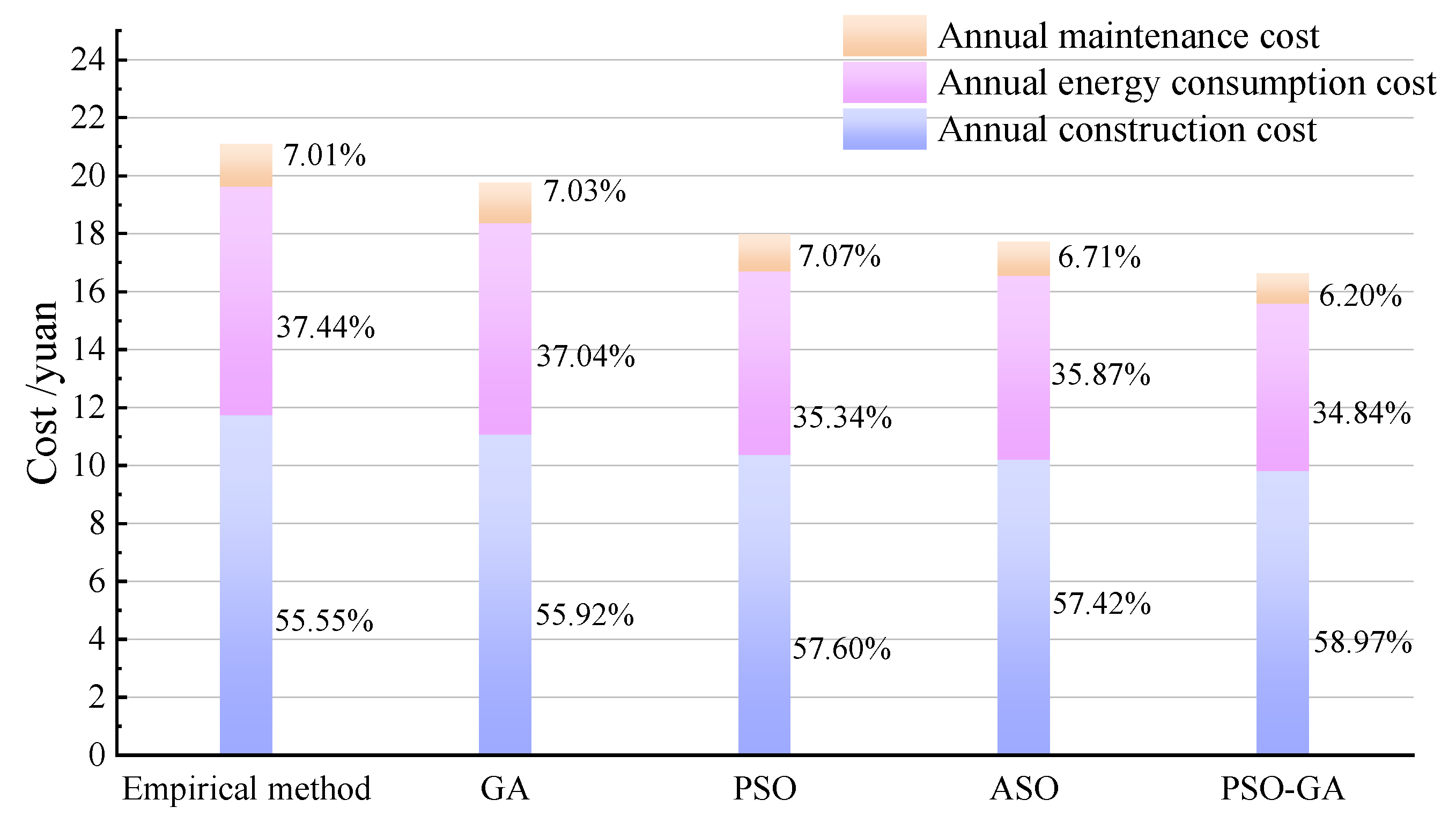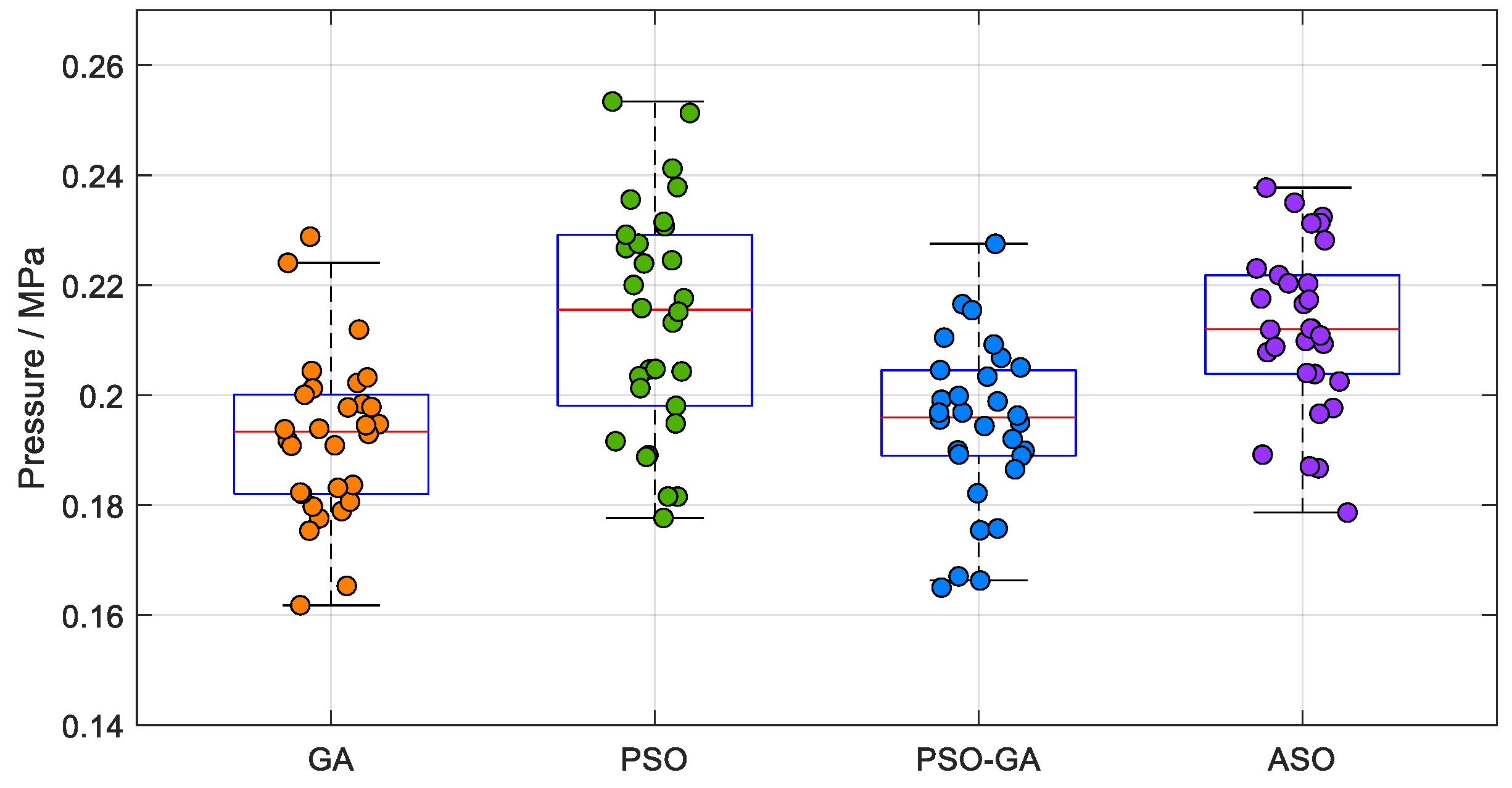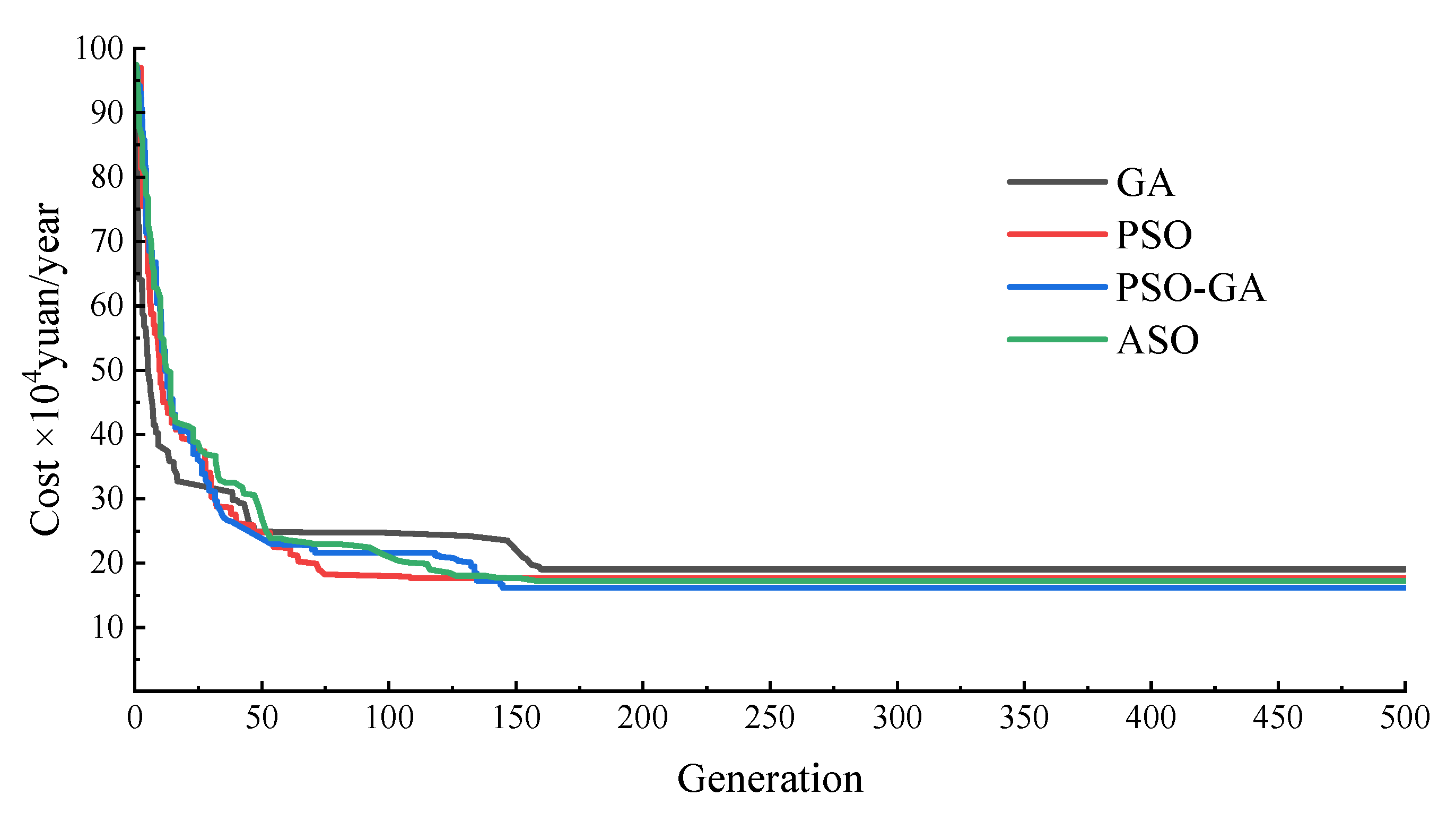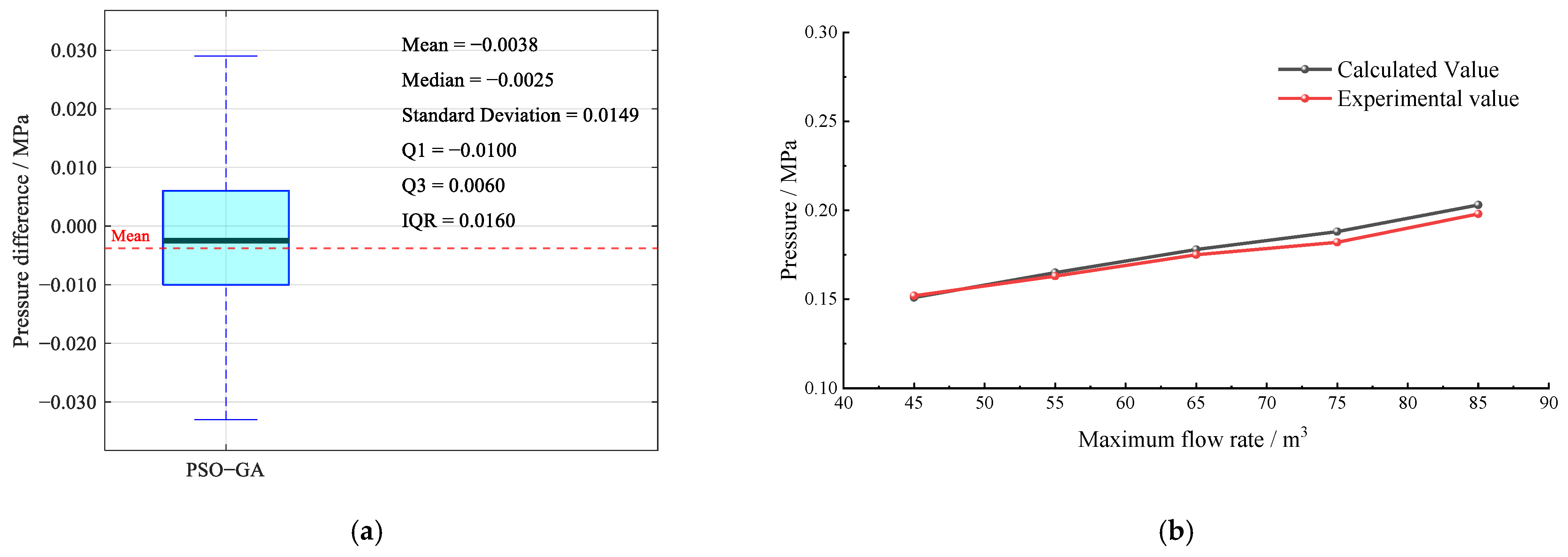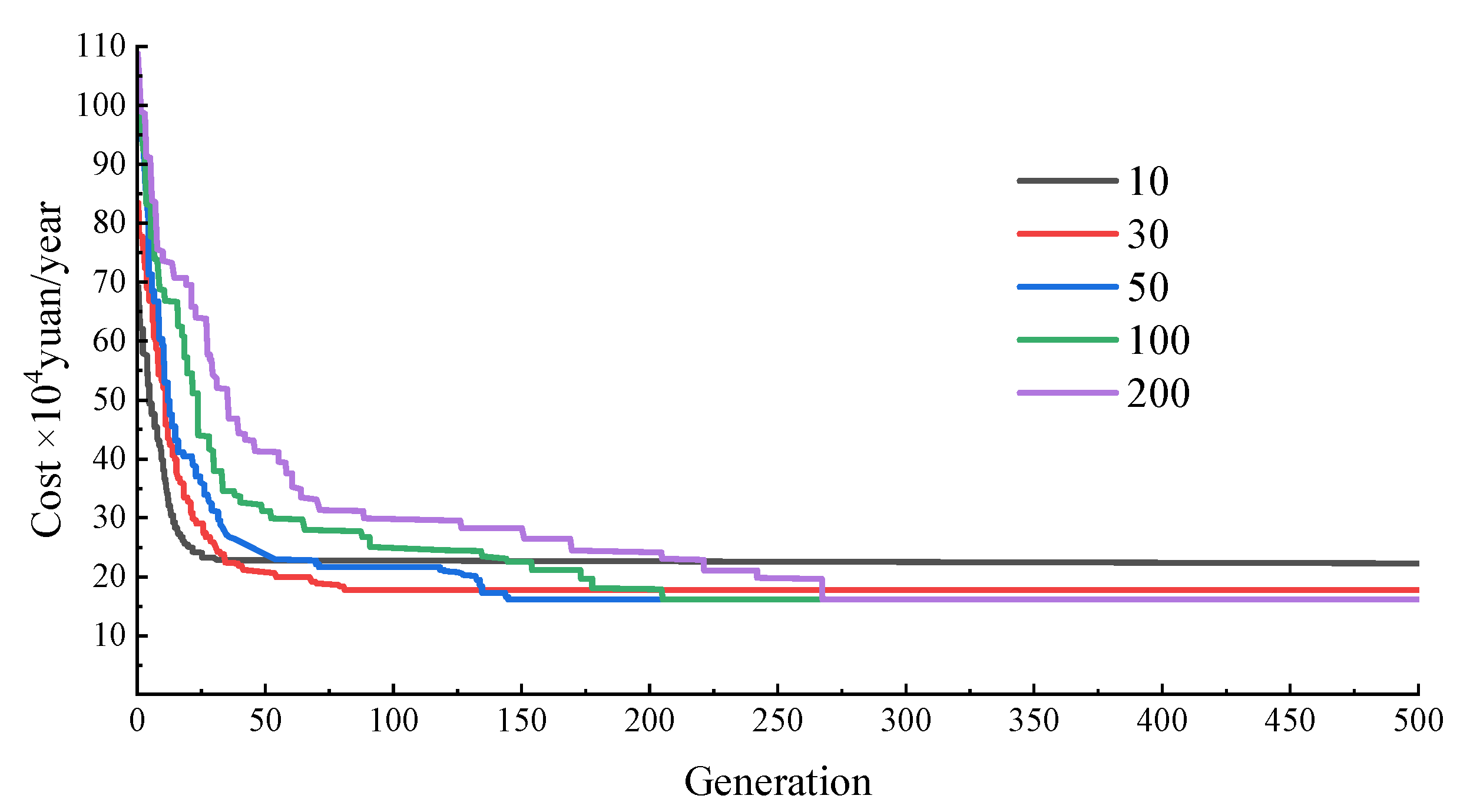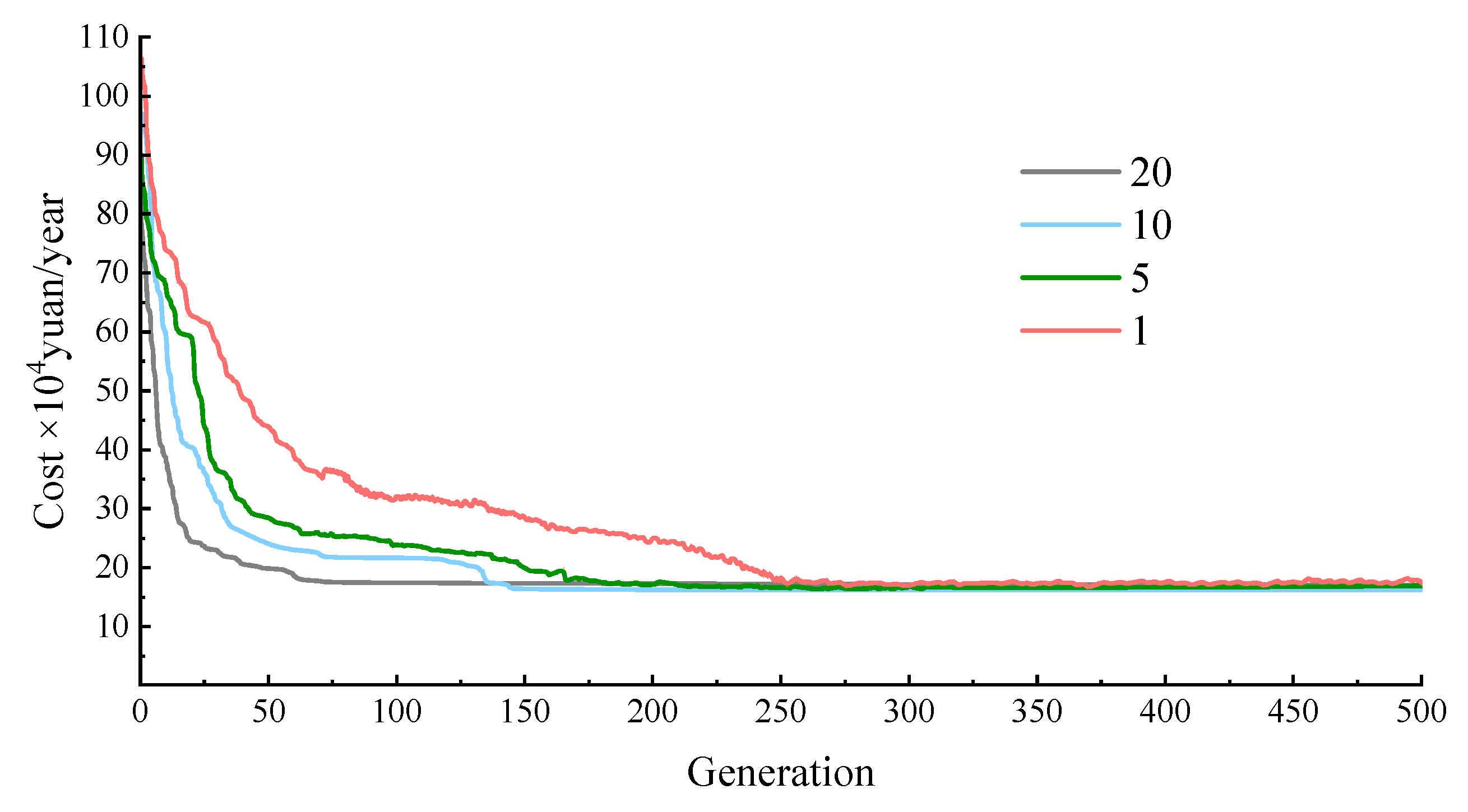1. Introduction
In areas with water shortages, the traditional extensive irrigation mode makes it difficult to coordinate the contradiction between water use and the sustainable development of agriculture [
1,
2,
3,
4]. Drip irrigation technology directly transports water and nutrients to the roots of crops through the pipe network system to achieve precise water control and on-demand supply. It has many advantages, such as reducing soil evaporation, improving irrigation efficiency, increasing crop yield, and providing strong adaptability to topography and soil. It is the key technology for realizing agricultural modernization and refinement. At present, the large-scale application of drip irrigation technology still faces cost barriers. The construction investment for a pipe network accounts for more than half of the cost of a drip irrigation system [
5]. The optimal design for a drip irrigation system pipe network is an important aspect of efficient water distribution in the agricultural environment. The scientific selection of economical and effective pipe network parameters remains a hot research topic. Many scholars have proposed various schemes for optimizing drip irrigation pipe network systems to achieve a cost-effective, stable, and reliable drip irrigation pipe network system designs.
Drip irrigation network optimization is a typical complex nonlinear problem. Reasonable pipe network planning and parameter selection can effectively reduce the construction and operation costs of drip irrigation systems. Compared with designs using traditional empirical methods, intelligent algorithms can quickly and reliably obtain better solutions to achieve pipe network optimization. Dandy et al. [
6] proposed a nonlinear model considering the shift mode, pipe size, and pump performance which divided the field into sub-units to determine the lowest cost solution. Yoo et al. [
7] used the harmony search algorithm to estimate the optimal diameter for an irrigation water supply system in circular agriculture and verified the practical application of this optimization technology in the design of irrigation systems in their actual research area. Masoumi et al. [
8] considered both the investment and annual energy costs and designed an on-demand pressurized irrigation network using multi-objective optimization. In their study, the network layout and the pipeline size were optimized at the same time, and an economical, efficient, and energy-saving irrigation system was designed.
Klyushin et al. [
9] proposed an AI system based on modern mathematical methods for the optimal control and design of drip irrigation systems. This method optimizes the design and control of drip irrigation systems to achieve sustainable agriculture and effectiveness in environmental protection. Zhao et al. [
10] simultaneously optimized pipe network layout and pipe diameter based on a genetic algorithm. Their case shows that the optimized pipe network layout and pipe diameter effectively reduced the investment costs by 21.3% and solved the problem of low design efficiency and high costs in self-pressure drip irrigation systems. Duan et al. [
11] proposed an optimization method for a large-scale, multi-stage gravity drip irrigation pipe network system based on an atomic search algorithm and simultaneously optimized the pipe network layout and the selection of the pipe diameter in a two-stage gravity drip irrigation system in Xinjiang, China. Zhang et al. [
12] proposed a chaotic beetle swarm optimization (CBSO) method and applied it to the optimization of an intelligent drip irrigation control system. The response time of PID control in a drip irrigation control system optimized using this algorithm was short, and the performance of the system improved. Bakhtiar Karimi et al. [
13] proposed an adaptive neuro-fuzzy inference system based on fuzzy c-means clustering combined with an ANFIS-FCM-PSOGSA algorithm to accurately select the distance between the lateral pipe and the nozzle and effectively optimize the nozzle depth. In recent years, Fan et al. [
14] used the Jaya algorithm to optimize the pipe layout and the pipe diameter selection in a drip irrigation network system, thereby optimizing the pipe network parameters of a drip irrigation area in Xinjiang, China. Wang et al. [
15] established a prediction model for the critical non-depositional velocity of sediments in a drip irrigation branch pipe based on the PSO-SVM method. Chili Lima et al. [
16] used an AquaCrop Plug-in-PSO method to optimize irrigation scheduling for maize. Batmaz et al. [
17] optimized the design of a large-scale water distribution network using CSBO. Córdoba et al. [
18] used a GA to reduce the heterogeneity of the flow in drip irrigation networks. Good optimization results were achieved. Considering various factors such as cost, energy efficiency, and system reliability, the above scholars have optimized the pipe network design for various drip irrigation systems using innovative methods and optimization techniques and improved the performance and sustainable development of agricultural irrigation systems.
Particle swarm optimization (PSO) is a commonly used optimization algorithm for pipeline network planning and parameter selection [
19,
20,
21], but it is prone to falling into local optima problems when dealing with parameter optimization problems in complex scenarios. In response to this defect, many scholars have effectively improved the PSO algorithm and applied it to urban water supply [
22,
23], submarine oil [
24], natural gas [
25], and even nuclear power [
26].
This study proposes a multi-constraint optimization model that simultaneously considers the annual construction, energy consumption, and maintenance costs of a drip irrigation network. To address the local optimum issue associated with the PSO algorithm, the GA algorithm is introduced to enhance the optimization efficiency and outcomes. The hybrid PSO-GA algorithm effectively optimizes both the network topology and parameter selection. The reliability of the proposed model and optimization approach is verified using a vegetable planting test field as a case study. The results demonstrate that the total annual cost of the drip irrigation network design obtained using the PSO-GA algorithm is reduced by up to 21.2% compared with the traditional empirical method, the PSO algorithm, the GA algorithm, or the atom search optimization (ASO) algorithm. The PSO-GA algorithm successfully address the PSO algorithm’s tendency to converge to local optima and overcomes the premature convergence issues commonly observed in the GA algorithm. Through multi-stage variable diameter optimization of the pipe size and flow rates, pump power and head loss are significantly reduced, leading to substantial savings in operating costs. The proposed method effectively balances multi-objective conflicts under complex constraints, providing a robust and efficient optimization paradigm for drip irrigation network design.
5. Discussion
5.1. Sensitivity of Input Parameter
To further determine the impact of input parameters on the final results, the single parameter perturbation method was used to conduct a sensitivity analysis on the input parameters of the drip irrigation network system optimized by the PSO-GA algorithm. By keeping other parameters constant and adjusting the value of the target parameter by ±10%, we observed the sensitivity of the objective function to the change in a single parameter and quantified it using the sensitivity coefficient, with the sensitivity coefficient being calculated according to Equation (15). The sensitivity coefficients are shown in
Table 9.
where
is the sensitivity coefficient,
is the variation of parameter,
is the parameter value,
is the variation of total cost, and
is the value of total cost.
The results indicated that pump efficiency, flow rate, and total pump head had a greater impact on the annual total cost, with relative change rates all exceeding 5%. This was because these factors directly determined the system’s annual energy consumption. Notably, the sensitivity coefficient of pump efficiency to cost was negative, as higher pump efficiency reduced energy losses and thus lowered costs. In contrast, the impact of electricity prices on the annual total cost was moderate, with a sensitivity coefficient of only 0.218, since the proportion of electricity charges in the overall cost was relatively small. Similarly, the pipeline length had little effect on the annual total cost, as the change in pipeline construction costs was amortized over the service life of the system, resulting in a limited impact.
5.2. Sensitivity of Algorithm Parameter
Although this study proposes an effective method for optimizing drip irrigation pipe network systems, there were certain limitations. First, the study focused mainly on comb pipe network layouts; other layout patterns warrant further exploration. Second, the research was constrained by the field situation of the case study site, where the pump position was fixed, thereby limiting the extent of optimization. If the position of the pump could have been freely selected, the system layout may have been further optimized. Additionally, due to the computational cost limitations, each algorithm was run only 30 times, which may have introduced statistical variability and led to fluctuations in satisfaction rates, making it difficult to accurately reflect the true distribution characteristics with such a small samples size.
Furthermore, the performance of the PSO-GA method was highly sensitive to parameter setting. Key factors such as the number of particles and the algebraic interval of the GA operations directly affected the algorithm’s convergence speed, global search ability, and computational efficiency. The influence of the particle number on algorithm convergence is shown in
Figure 9. The influence of the GA operation interval is shown in
Figure 10. Moreover, the fixed position of the pump in this study imposed certain limitations on the optimization outcome. If the pump position could have been freely adjusted, further improvements to the final layout would have been possible. Additionally, due to constraints on computational resources, each algorithm was only run 30 times. This limited number of runs introduced potential statistical variability results, which may have resulted in the constraint satisfaction rate being abnormally high or low, making it difficult to reflect the true distribution based on small sample statistics.
As shown in
Figure 11, when the particles number was small, the algorithm converged much faster than when the particle number was larger. For instance, with 10 and 30 particles, convergence was achieved at 24 and 78 iterations, respectively. However, the resulting solutions were not global optima. As the number of particles increased, the convergence speed slowed down. For example, for 50 to 200 particles, the number of convergence iterations increased from about 148 to 215 but the final results consistently reached the global optimum. This demonstrates that a larger swarm size enhanced the spatial coverage ability of the algorithm, effectively reducing the risk of falling into the local optima. However, for complex objective functions such as drip irrigation pipe network design, a larger particle number significantly increases computational cost. A small particle number may lead to premature convergence, missing the global optimum. In PSO-GA, the PSO algorithm was used as the initial population source of GA, and a reasonable number of groups could provide more high-quality candidate solutions for GA while saving computing costs.
It can be seen from
Figure 12 that when the GA operation interval was short, the number of iterations for the algorithm to achieve convergence increased. For example, when the algebraic intervals were 1 and 5, the algorithm approached convergence at approximately 250 iterations and 180 iterations, respectively; however significant oscillation occurred, and true convergence was not achieved by the end of the computation When the algebraic interval was set to 10 and 20, oscillations were reduced, and convergence was reached at 148 and 67 iterations, respectively. Nevertheless, the results indicate that when the algebraic interval was 20, the final cost was slightly higher than the optimal solution. These results demonstrate that a short algebraic interval can effectively prevent population homogenization through perturbations, but it may also disrupt high-quality solutions, leading to oscillations and prolonged convergence times. When the interval is long, dominant solutions are retained and convergence toward the current optimal region is accelerated, although this reduces population diversity and increases the risk of fall into a pseudo-global optimum.
The performance of the PSO-GA algorithm strongly depends on the design of the hybrid strategy and parameter tuning. In this study, a particle swarm size of 50 and a GA operation interval of 10 generations were selected, which proved to be reasonable and effective. In practical applications, appropriate parameters should be determined through small-scale experiments and further adjusted based on the specific characteristics of the problem to achieve an effective balance between computational accuracy and efficiency.
The cost and constraint violation rate were very sensitive to the number of particles, as shown in
Figure 13. When the number of particles was small, the system cost was relatively high. Once the number of particles exceeded 50, the cost stabilized, indicating that the global optimal solution could be obtained with 50 particles, achieving a final cost reduction of 60,900 yuan. When the particle swarm size was small, particles were sparsely distributed, making it difficult to cover areas with complex constraints and leading to a constraint violation rate of 40.23%. When the particle number exceeded 50, the violation rate decreased to 27.26%. However, too many particles caused repeated exploration of invalid regions, resulting in increased constraint violations. The mutation interval had little effect on the cost, but frequent mutations caused fluctuations in the final result, making it difficult to approach the global optimum. In addition, frequent mutations increased the constraint violation rate when approaching convergence. Therefore, when the mutation interval was small, the constraint violation rate was 17.81% higher compared to a larger mutation interval.
7. Limitations and Future Work
This study focused solely on the economic benefits of a pipeline network system by minimizing the total annual cost as a single objective, without considering ecological effects such as water resource utilization or carbon emissions. Moreover, the study was limited to comparisons with meta-heuristic algorithms and did not incorporate deterministic mixed integer nonlinear programming (MINLP) solvers to prove its superiority over the classical baseline model.
Future research should integrate multi-objective optimization algorithms to balance economy, environmental, and system reliability objectives, thereby improving system sustainability. Furthermore, the current model is based on static parameters, such as fixed running days and electricity price, and its universality relative to larger scale farmland and multi-level terrain needs to be further verified. Future studies could optimize the model by incorporating dynamic variables and adapting it to different environmental terrain to enhance its robustness.
